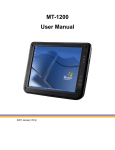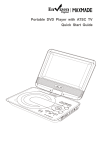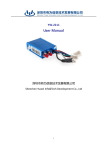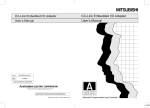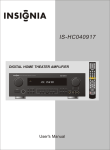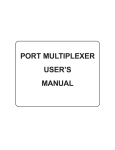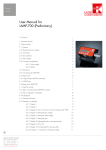Download 54Mbps USB Wireless Adapter User Manual
Transcript
54Mbps USB Wireless Adapter User Manual CONTENTS Revision History……………………………….……………………………2 Introduction………………………………………………………….............3 Package Contents…………………………………………………............3 Minimum System Requirements………………………………………….3 Connecting the Wireless Adapter……………………………………............4 Status LEDs………………………………………………………………….5 Installing the Wireless Adapter……………………………………………...6 Windows XP…………………………………………………………………6 Install the Wireless Adapter Driver and Utility……………………...........6 Configuring the Wireless Utility………………………………………...10 Configuration……………………………………………………………12 Uninstalling the Wireless Adapter Driver and Utility…………………...16 Windows 2000……………………………………………………………...19 Install the Wireless Adapter Driver and Utility………………………….19 Configuring the Wireless Utility………………………………………...23 Configuration…………………………………………………………....25 Uninstalling the Wireless Adapter Driver and Utility…………………...29 Trouble shooting……………………………………………………………31 1 Revision History Revision Updated Notes 2 Introduction Thank you for purchasing the Wireless Adapter. This Wireless Adapter is easy to use and easy to setup. If you are tired of all those messy wires needed to connect a lap-top to your Home network, and then take your networking to the next level with the Wireless Adapter. You will be able to share files, printers and even your High-Speed Internet access wirelessly. Package Contents Make sure the following items came in this package: ¾ Wireless Adapter ¾ Wireless Adapter Installation and User’s Manual CD Minimum System Requirements ¾ Microsoft Windows XP, or Windows 2000 installed 3 Connecting the Wireless Adapter 1. Your computer can be on or off; it will not affect the installation process. Locate an available USB slot on your PC. If you are not sure where this may be, please consult your computer’s User Manual. 2. Insert the Wireless Adapter into the appropriate USB slot. Your hardware is now installed. 4 Status LEDs LED Status LED1 on (Red) LED1 off LED2 speed blink (Orange) LED2 blink (Orange) MEANING WLAN card activity Connect with Access Point All other status Data Transferred / Data Received Scanning for the Access Point 5 Installing the Wireless Adapter Windows XP  NOTE: If you have installed the Wireless Adapter driver before, please uninstall the old version first. Install the Wireless Adapter Driver and Utility 1. After you have installed the Wireless Adapter your computer will display a Found New Hardware Wizard screen, click "Cancel" to continue. 6 2. Insert Installation CD into your CD-ROM, then the installation will be activated automatically. If not, double-click on "w89c35.EXE" on the installation CD. 3. Winbond Wireless Setup will install the driver and utility on your system, click "Next" to continue. 4. On the Select Destination Directory screen, click "Next" to accept the Destination Directory for driver installation. 7 5. Press the "Next" button to begin the installation. 6. Wireless Adapter Driver and Utility are installing. 7. If you see the Windows Logo testing message, below, please press "Continue Anyway" to proceed. 8 8. The installation is now complete, please click "Finish".  NOTE: When you complete the installation, the utility icon will appear on the system tray. If not, it means that the installation failed. Please uninstall the driver and repeat the process. 9 Configuring the Wireless Utility  NOTE: If you have installed the Windows XP Service Pack 2. You can use the Windows Zero Configuration for Wireless Configuring. Please see the Windows XP User Guide. 1. On the Notification Area, right-click the Winbond Utility icon. 2. Winbond Utility Selection screen will be displayed, click "Stop Windows Zero Configuration". in your system tray to begin the utility configuration. 3. Double-click the utility icon Select Site Survey Tab, all available Access Points would be listed. Click on the desired Access Point, and click the "Config" button for Wireless configuring. 10 4. On the Wireless Network Properties screen, you may set Network Name (SSID), Wireless Network Security Key or AD-HOC network. 5. Click on the desired profile, and click the "Connect" button to take effect. 11 Configuration z Profile The Profile Tab allows you to set values for all parameters by selecting a previously defined profile. To create a profile, click Add, type a profile name and set the corresponding parameters. If one of the profiles is no longer used, you may remove it by clicking the Delete button. After changing parameters, click the Connect button to take effect. You can have multiple profiles and modify the profile at any time. z Site Survey Site Survey Tab lists the features of the available Access Points within range of the Wireless Adapter's signal. Click on the desired Access Point, and click Config for Wireless Configuration. You may click Refresh to refresh the list. 12 z Advance The Configuration Utility also offers the advanced configuration for user to set the Wireless Adapter under certain network environment. These advanced options include RTS Threshold, Fragmentation Threshold, Preamble Type, Tx Rate, Power Save, and Valid Channel. 13 z Status Network Name The field shows the association status to available Access Point with SSID of the Access Point. Link Status Shows the whether the link is Connect or Disconnected. Current Channel Shows the channel on which the connection is made. Current Speed Shows the highest transmit rate of the current association. Link Quality / Signal Strength The Link Quality and Signal Strength bar graph is only active when the node is in Infrastructure Mode. The bar graph displays the quality and strength of the link between the node and its Access Point. Singnal Noise This displays the noise level of the link between the node and its Access Point. 14 z Information About Tab shows the product version including the detail of Configuration Utility, Driver, and NIC MAC Address. 15 Uninstalling the Wireless Adapter Driver and Utility 1. For uninstalling the Wireless Adapter, please go to: Start->Settings->Control Panel->Add or Remove Programs->Winbond WLAN under Windows environment. Then click "Remove". 16 2. On the next screen, click "Next" button to accept automatically uninstall for Wireless LAN Driver. 17 3. Click "Finish" button. 4. The USB Wireless Adapter can now be safely removed from the system when the un-installation is done. 18 Windows 2000 Install the Wireless Adapter Driver and Utility 1. After you have installed the Wireless Adapter your computer will display a Found New Hardware Wizard screen, click "Cancel" to continue. 2. Insert Installation CD into your CD-ROM; then the installation will be activated automatically. If not, double-click on "w89c35.EXE" on the installation CD. 19 3. Winbond Wireless Setup will install the driver and utility on your system, click "Next" to continue. 4. On the Select Destination Directory screen, click "Next" to accept the Destination Directory for driver installation. 20 5. Press the "Next" button to begin the installation. 6. Wireless Adapter Driver and Utility are installing. 7. A dialog saying "Digital Signature Not Found" might appear to warn you that the device hasn’t got Microsoft Digital Signature. Select "Yes" to continue the installation, the software has been tested and proved to work correctly with Windows. 21 8. The installation is now complete, please click "Finish". 22 Configuring the Wireless Utility 1. Double-click the utility icon in your system tray to begin the utility configuration. 2. Select Site Survey Tab, all available Access Points would be listed. Click on the desired Access Point, and click "Config" button for Wireless configuring. 23 3. On the Wireless Network Properties screen, you may set Network Name (SSID), Wireless Network Security Key or AD-HOC network. 4. Click on the desired profile, and click the "Connect" button to take effect. 24 Configuration z Profile The Profile Tab allows you to set values for all parameters by selecting a previously defined profile. To create a profile, click Add, type a profile name and set the corresponding parameters. If one of the profiles is no longer used, you may remove it by clicking the Delete button. After changing parameters, click the Connect button to take effect. You can have multiple profiles and modify the profile at any time. z Site Survey Site Survey Tab lists the features of the available Access Points within range of the Wireless Adapter's signal. Click on the desired Access Point, and click Config for Wireless Configuration. You may click Refresh to refresh the list. 25 z Advance The Configuration Utility also offers the advanced configuration for user to set the Wireless Adapter under certain network environment. These advanced options include RTS Threshold, Fragmentation Threshold, Preamble Type, Tx Rate, Power Save, and Valid Channel. 26 z Status Network Name The field shows the association status to available Access Point with SSID of the Access Point. Link Status Shows the whether the link is Connect or Disconnected. Current Channel Shows the channel on which the connection is made. Current Speed Shows the highest transmit rate of the current association. Link Quality / Signal Strength The Link Quality and Signal Strength bar graph is only active when the node is in Infrastructure Mode. The bar graph displays the quality and strength of the link between the node and its Access Point. Singnal Noise This displays the noise level of the link between the node and its Access Point. 27 Information About Tab shows the product version including the detail of Configuration Utility, Driver, and NIC MAC Address. 28 Uninstalling the Wireless Adapter Driver and Utility 1. For uninstalling the Wireless Adapter, please go to: Start->Settings->Control Panel->Add or Remove Programs->Winbond WLAN under Windows environment. Then click "Remove". 2. On the next screen, click "Next" button to accept automatically uninstall for Wireless LAN Driver. 29 3. Click "Finish" button. 4. The USB Wireless Adapter can now be safely removed from the system when the un-installation is done. 30 Trouble shooting PING This section discusses possible solutions using ping command to find your problem if you can’t connect to the network. 1. Check if you have a valid IP address 2. Test if your TCP/IP works. Under MS-DOS (command prompt), type “ping localhost”. If you didn’t receive a reply, then you need to re-install your TCP/IP. Proceed to next step if you have received replies. 3. Using the same procedure, try to ping your Wireless Adapter’s IP. command fails, check the following: • Your WLAN is connected • Check that your driver is correctly installed. If the Ping 31 Checking Valid IP Addresses There are restrictions on which IP and addresses you can and cannot use. Some IP addresses are reserved for testing, multicasting and some IP are restricted by your ISP. Following IP addresses cannot be used: ¾ 127.x.x.x – this is a loop back address, used for testing ¾ 0.0.0.0 – this IP address represent the host address ¾ 255.255.255.255 – this is local broadcast address ¾ First portion of IP cannot exceed 224, that is, IP addresses which is in the range of 224~239.x.x.x is not valid. This range of IP is for multicasting. IP range from 240~255.x.x.x are reserved IP addresses and cannot be used. ¾ 0 or 255 in host ID portion of your IP are not valid. This represent local host or broadcast address for your class of IP IP has five classes, namely class A, B, C, D and E. For each class, the host ID portion in the IP field is different for each of the classes. Figure below illustrate this. Class A: 1 ~ 127. Host ID Class B: 128 ~ 191. Class C: 192 ~ 223. X. Class D: 224 ~ 239. Used for Multicasting (no Host ID) Class E: 240 ~ 255. Reserved IP address X. Host ID X. Host ID Host ID cannot be all 0’s or all 255’s. Note: X denote don’t cares in the above example. 32

































